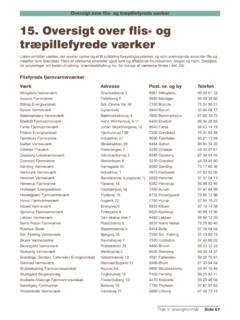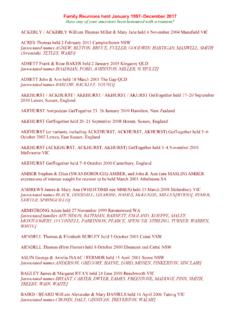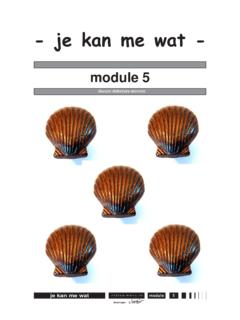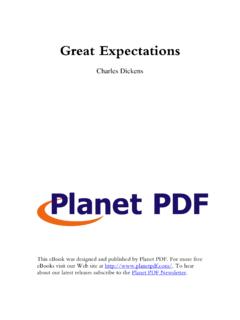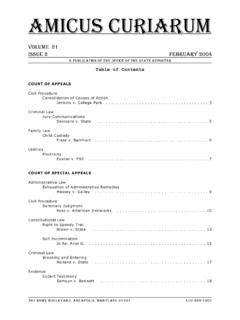Transcription of 9. CHP and Power Plants - Videncenter
1 In 1986 the Danish Government madean energy policy agreement on the con-struction of decentralised CHP plantswith a total Power output of 450 MW,fired with domestic fuels such as straw,wood, waste, biogas, and natural gas,to be completed by the year 1995. In1990 the government made anotheragreement on the increased use of nat-ural gas and biofuels to be accom-plished primarily by means of the con-struction of new CHP Plants and retro-fitting the existing coal and oil-fired dis-trict heating Plants to natural gas andbiomass-based CHP Generation PrincipleAt a traditional steam-based, coal-firedCHP plant with condensation operation,40-45% of the energy input is convertedto electrical Power , while the remainingpart is not utilised. It disappears with thecooling water into the sea and with thehot flue gas from the boiler up throughthe chimney into thin back pressure CHP plant gener-ates electrical Power in the same way asa Power plant, but instead of dischargingthe condensation heat from the steam to-gether with the cooling water into thesea, the steam is cooled by means of therecycling water from a district heatingdistribution system and thus used for thegeneration of heat.
2 The advantage ofcombined heat and Power production isthat up to 85-90% of the energy in thefuel input can be utilised. Of this % of the energy input will be con-verted to electrical Power , while 55-70 %of the energy input will be converted toheat. Thus by combining heat and electri-9. CHP and Power Plantscal Power generation, the total utilisationof energy increases, but as a whole theelectrical Power output will be advantage of a back pres-sure CHP plant instead of a Power plant isthat there is no need for seawater forcooling. The plant can therefore be lo-cated near large towns (decentralised)with sufficient demand and a distributionsystem to cope with demands. The opera-tion of a CHP plant depends on the heatdemand of the district heating system. Incase of a small heat demand, the powergeneration will also be small, because thedistrict heating water cannot cool thesteam cycle to that extent at the CHPplant. For the purpose of equalising thevariations in the cooling of the districtheating water, the CHP Plants are oftenequipped with storage tanks for the stor-age of heat during periods with little dis-trict heating is the system steam data on pres-sure and temperature that determine theelectrical Power utilisation of the equal steam data for a coal-firedpower plant and a biomass-fired powerplant, the electrical Power efficiency willalso be the same.
3 However, the risk ofslagging and corrosion during firing withbiofuels has deterred boiler engineers andmanufacturers from applying steam datato biomass-fired heating Plants at thesame level as coal-fired heating most recent advances in the field ofheating system technologies and designhave constituted a break-through, and acouple of new heating Plants demonstratethat high steam data can also be achievedby biofuels. This is set out in more detailunder the description of the heating plantsat Masned , Ensted, and Aved number of industrial enterprises re-quire steam for their manufacturing pro-cesses. Several large enterprises haverealised the advantage of establishingsteam production Plants , so that in addi-tion to the process steam, electricalpower can also be generated. Espe-cially in forest product industries, thisopportunity is quite evident, since woodwaste can then be utilised as a fuel onthe spot. The energy can naturally onlybe utilised once, so when energy isdrawn off in the form of process steam,the electrical Power output and perhapsalso the generation of heat are process steam is normally extractedfrom a special type of steam turbinetermed an extraction turbine.
4 Dependingon the steam requirement, steam can bewithdrawn at various high-pressurestages of the turbine, thereby applyingvarious methods for the adjustment ofthe steam Plants owned by electricalpower companies are under the obliga-tion to supply electrical Power to the sup-ply mains. Decentralised CHP plantsowned by district heating companies andindustrial enterprises are not likewisecommitted. Heating Plants owned byelectrical Power companies must there-fore be constructed so as to includegreater operational reliability which re-sults in larger capital Owned by ElectricalPower CorporationsM bjergv rket, HolstebroIn M bjerg near Holstebro, has constructed a CHP plant,Figure 24: By separate electrical Power generation and generation of heat at a Power plant and at a district heating plant, totallosses are much larger than by combined heat and Power production at a CHP powergeneration 40%Loss 60% Power plantElectrical powergeneration 25%Loss 15%DecentralisedCHP plantGenerationof heat 60%Loss 15%Districtheating plantGenerationof heat 85%CHP and Power PlantsPage 48 Wood for Energy Productionfired with waste, straw, wood chips, andnatural plant is noteworthy because itdemonstrates the combined applicationof renewable and fossil fuels in a way inwhich one of the positive properties ofnatural gas (low content of impurities) isutilised so as to increase the aggregateenergy output.
5 Furthermore, the increasein the energy output is achieved withoutwasteful use of gas, which as known is alimited system is divided into threeboiler lines, two for waste and one forstraw and wood boilers were delivered byAnsaldo V lund A/S, and all three boilersare equipped with a separate naturalgas-fired superheater so as to increase thesteam temperature from 410 C to 520 Cat a pressure of 65 bar. By superheatingthe steam, a more energy efficient processis achieved in the form of increased electri-cal Power efficiency with reduced risks ofcorrosion of the superheater is fired in the form of wholebig bales into six cigar burners , in-stalled three and three opposite one an-other. The wood chips are fed by meansof a pneumatic feeding system on to anoscillating grate, where unburned strawand wood chips burn flue gas from the straw and chip-fired boiler is cleaned in a bag filter to adust content of max. 40 mg/m3n. In thecase of the waste-fired boilers, the fluegas purifying is supplemented with limereactors for the purpose of reducing hy-drogen chloride, hydrogen fluoride andsulphur oxide emissions.
6 The three boil-ers have separate flues in the 117 metrehigh chimney. The straw and chip-firedboiler can operate 100% on either woodchips or straw or combined wood chipsand waste-fired boilers (traditionalgrate-fired V lund waste-fired boilers)have an input capacity of 9 tonnes ofwaste per hour (calorific value GJper ton), and the capacity of the strawand chip-fired boiler is 12 tonnes perhour with the average calorific value be-ing 14 GJ per electrical Power output is 30 MWeand 67 MJ/s heat. The system isequipped with district heating storagetank the size of approx. 5,000 is supplied to the district heatingsystems in Holstebro and CHP PlantThe CHP plant in Vejen is a special com-bined fuel system, because the steamproducing boiler, delivered by AnsaldoV lund A/S, can be fired with eitherwaste, straw, wood chips, or output of the system is MWeand 9 MJ/s heat at a steam production tonnes per hour at 50 bar and 425 C. The turbine is an AEG Kanis chips and waste are fedon to a V lund Milj waste grate (sec-tional step grate).
7 Straw can be firedas whole big bales in a single cigarburner . The plant s annual consump-tion of wood was originally estimatedat approx. 1,200 tonnes per year. Theidea was to use wood as a supplemen-tary fuel in periods with too low calorificvalue of the waste. However, the an-nual consumption of wood chips is esti-mated to be reduced significantly, sincethe waste input has been of a suffi-ciently high calorific value and at thesame time, sufficient quantities ofwaste are a consequence, it is the intentionin the future only to use wood during thestarting up and closing down of the sys-tem. Environmental considerations pro-hibit the use of waste during those peri-ods, because the temperature in thecombustion chamber is too low for com-plete combustion to take 25: Schematic diagram of M bjergv gasFlue gasFlue gasFlue gasExhaustfanExhaustfanExhaustfanFly ashFlue gas cleaningFlue gas cleaningElectrofilterElectrofilterBag filterGeneratorElectricalpower60 kVTransformer10 kVGearSteam turbineSteamHeatingstorage tankAir cooling equipment5000 m3 PumpPumpPumpPumpPump35-55 C75-90 CHolstebroStruerDistrict heatingwaterStraw storageStraw tableStraw tableWood chipstorageFurnaceFurnaceFurnaceWaste siloWasteboiler 1 Wasteboiler 2 Naturalgas- chips, if necessaryWaste productWaste productBypass heatexchangergraphics: i/s vestkraftCHP and Power PlantsWood for Energy ProductionPage 49 Masned v rket (CHP Plant)Masned CHP plant that is owned by I/SSj llandske Kraftv rker (electricalpower corporation), was put into opera-tion in 1995.
8 It is a biomass-fired backpressure system for electrical Power anddistrict heating supply to boiler is designed for straw with 20%of the energy supplied by supplementaryfiring with wood chips. The annual con-sumption of fuel amounts to 40,000tonnes of straw and 5-10,000 tonnes ofwood steam data of the plant are 92bar and a steam temperature of 522 electrical Power efficiency is MW,while the heat output that can be sup-plied to the district heating system is The input is boiler, constructed by Burmeister& Wain Energy A/S, is a shell boiler withnatural circulation. It is a retrofit system,where the steam data have been boldlyset close to standard coal-fired Plants ofthe same size, despite the fact that theprimary fuel here is straw. Experiencesacquired from operating the system inpractice suggest that the system conceptis boiler has two feeding systems,one consisting of a straw shredder fol-lowed by a screw feeder. The chipfeeding system consists of transport andscrew feeders in the bottom of the silo tothe straw-fired unit.
9 The wood chips aremixed with the straw and fired togetheron to a water-cooled oscillating rketDenmark s largest electrical Power plantboiler exclusively fired with biofuel wasput into operation in 1998 at Ensted-v rket near system that has been deliveredby FSL Milj A/S and Burmeister & WainEnergi A/S, is located in the old building ofthe earlier coal-fired Unit 2. The systemconsists of two boilers, a straw-fired boilerthat produces steam at 470 C, and achip-fired boiler that superheats the steamfrom the straw boiler further to 542 superheated steam is passed to thehigh-pressure system (200 bar) ofEnstedv rket s coal-fired Unit 3. With anannual consumption of 120,000 tonnes ofstraw and 30,000 tonnes of wood chips,equal to an input of MJ/s, the thermalefficiency of the biomass boiler is 88 MWof which a proportion of MW electri-cal Power is generated (approx. ofthe total electrical Power generation ofUnit 3). The biomass boiler is thus consid-erably larger than the largest of the de-centralised biomass-fired CHP gross electrical Power efficiency isapprox.
10 41%. Annual efficiency is ex-pected to be a little lower due to the incor-poration with Unit 3 and varying load con-ditions. It is the intention that the biomassboiler will operate 6,000 hours per year atfull load. With a storage capacity of only1,008 bales, equal to the daily consump-tion, deliveries of 914 big bales will be re-quired on average a day, equal to 4 truck-loads per hour for hours a straw boiler is equipped withfour straw lines. However, only three sys-tem lines can operate 100% (at full load).Each of the straw lines consists of a fire-proof tunnel, chain conveyors, strawshredder, fire damper, screw stoker, anda feed tunnel. Like the straw shredder atMasned v rket, the straw shredder isdesigned as two coupled, conical, verti-cal screws towards which the straw baleis pressed. From the straw shredder, theshredded straw is dosed via the firedamper into the screw stoker, whichpresses the straw as a plug through thefeed tunnel on to the chip boiler is equipped with twospreader stokers that throw the woodchips on to a grate.
